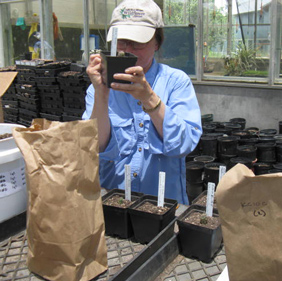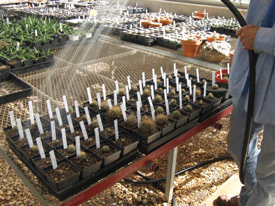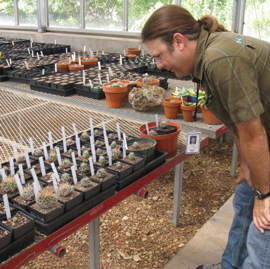Waiting Game
FOR MUCH OF THE YEAR, the Tobusch fishhook cacti (Ancistrocactus tobuschii) is easy to overlook. The small plant might reach the size of a golf ball in the dry, rocky terrain it favors. When fall rains come, a pale-yellow flower appears as early as February atop the thorns with fishhook-like ends that crisscross its green flesh.
The satiny flower helps conservationists track down this rare Texan. “It grows in stony clay and clay loams over limestone in the Edward’s Plateau and nowhere else in the world,” says Karen Clary, plant conservation manager at the Lady Bird Johnson Wildflower Center. “It’s known to grow in just eight counties here in Texas.”
The cactus shares unwanted company otherwise: it is one of 30 native plants considered threatened or endangered in the state and in need of help. To foster its survival, the Wildflower Center agreed to care for dozens of the cacti in late July. “We’re a way station, not a resting place for these plants,” Clary quickly points out, “because the important thing is to get them back out into the wild to keep making seeds and keep the population alive.”
Small clusters of those 79 Tobusch cacti, some the size of a little finger, had been growing in the new transmission line right-of-way being cleared along I-10 in Kimble County. These lines are being built by the LCRA Transmission Services Corp. as part of the state’s Competitive Renewable Energy Zones (CREZ) project. The new lines will bring wind power from West Texas to Austin and other Central Texas cities.

Minnette Marr, Wildflower Center plant conservationist, labels a potted Tobusch fishhook cactus in late July for future replanting in Kimble County. PHOTO Karen Clary
The state’s growing energy needs aren’t the plant’s only threat. Its listing under the Endangered Species Act in 1979 made it a target for traders on the black market. Beetles, jack rabbits and other creatures also dine on succulents such as Tobusch, and livestock may trample the low-profile plants.
LCRA, in cooperation with the U.S. Fish and Wildlife Service, enlisted the Wildflower Center and its cacti experts to care for the Junction-area population of Tobusch cacti. The hope is to reintroduce the plants a.s.a.p. back in Kimble County.
“Ideally the original landowners will be willing to accept the plants back,” says Biologist Erik Huebner from LRCA, who led the extraction from a 30-mile stretch near Junction. But he knows the reality may differ somewhat. Endangered plants in Texas aren’t protected on private property the way endangered animals are, but some landowners have already seemed leery of repatriating the plants and overseeing them perpetually.
As a result, private or public lands with appropriate habitat elsewhere in Kimble County may be sought. “The Wildflower Center’s goal is to relocate the plants back into the wild as close as possible to where they came from,” Clary says. “That is where they evolved and it will help keep us from accidentally shifting the species’ genetic characteristics in a new direction.”
Huebner’s main concern was getting the cacti to the Wildflower Center in the first place. “I was a little worried going into it that we wouldn’t be able to salvage them all, but it went very smoothly, with only a few dying after the fact,” he says. “That was partly about the good teamwork from all the players involved.”

Sean Watson, Wildflower Center nursery manager, gives some of the cacti a deep watering in their temporary greenhouse shelter. PHOTO Karen Clary
Huebner and LCRA Environmental Affairs colleague Chance Simpson tracked down the plants using GPS notes and flags. Those had been provided by an environmental consulting firm LCRA TSC hired to work during spring blooming. Cacti experts Jackie Poole from Texas Parks & Wildlife and Chris Best from U.S. Fish and Wildlife provided a detailed guide for unearthing the cacti, which Clary at the Wildflower Center streamlined before use.
Removing the succulents sometimes involved extricating roots that had tunneled into limestone cracks in search of water. Using small hand spades, LCRA staff spent three long days over two weeks digging up each plant and placing it inside a breathable, brown paper sack. The bags had a unique number that matched a number on another bag holding soil excavated from around the same plant’s roots.
After giving the cacti recovery time, Huebner brought about 60 to the Wildflower Center in late July to be overseen in the Center greenhouses. More came than were initially expected, but Nursery Manager Sean Watson quickly accommodated those plants and other Tobusch arriving a few days later.
“It’s not unusual for the numbers to be off,” says Watson, who has grown dozens of cacti species. “A cacti seed might fall down under ‘mama’ and a seedling might grow there that wasn’t identified at first.”
With Center Plant Conservationist Minnette Marr, Watson carefully potted each Tobusch and gave them a deep watering in their Kimble County soil. He added a special soil supplement that had helped other Tobusch the Center housed for Parks & Wildlife the previous summer.

LCRA biologist Erik Huebner inspects the repotted cacti. PHOTO Karen Clary
All but the smallest Kimble County cacti were left alone for weeks to adjust to their new quarters, where sunlight and other factors remain relatively constant. Another population of Tobusch that an energy company will dig up will join the 79 soon — but be housed separately.
“You don’t want to let those populations cross-pollinate, because if you mix genetics between populations, it could cause ill effects to one or both,” Watson notes.
It’s that type of hands-on knowledge that Clary believes brings conservation-minded organizations to the Center’s doorstep. In addition to holding Tobusch fishhook cacti, the Center is caring temporarily for endangered Texas poppy mallow and houses about a dozen other state plants that are endangered or rare in the wild.
“We were the closest garden with the facilities and the right climate to care for the Tobusch,” Clary says, “but our expertise helps as well.”

